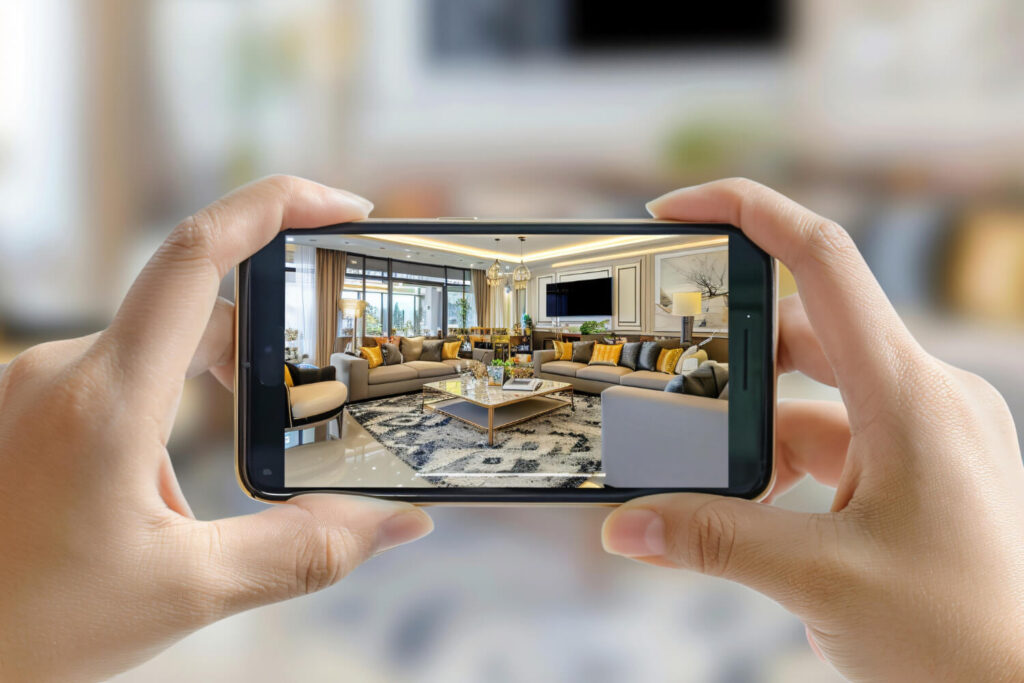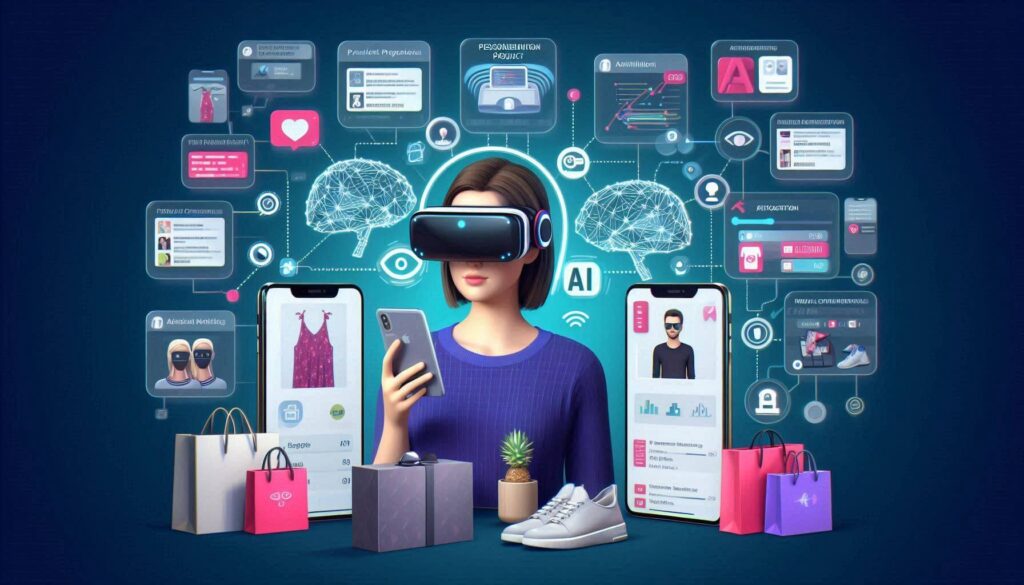Elevate Your Retail Experience with AR
Experience the future of shopping with AR. Get in touch with our team of experts today!


*

The retail landscape in today’s world is growing increasingly competitive and standing out requires more than just offering products – it demands delivering unforgettable experiences that deeply resonate with their customers. To address this, Augmented Reality (AR) is capable of revolutionizing how the retail consumers interact with brands and products. AR can help in enhancing engagement, personalization, and overall satisfaction by integrating digital elements into physical shopping environments, thereby boosting both online and offline sales.
Augmented Reality (AR) enriches real-world environments by overlaying digital information like images, videos, or 3D models onto physical spaces. Unlike Virtual Reality (VR), which creates entirely simulated environments, AR enhances existing surroundings. In retail, AR applications empower customers to virtually interact with products, visualize how items would look or fit in their own spaces, and experience products in ways previously unimaginable through traditional shopping methods.
Augmented Reality (AR) is reshaping the retail industry by offering a plethora of benefits that enhance customer engagement, personalize shopping experiences, reduce return rates, increase sales conversion, and differentiate brands in a competitive marketplace.
AR transforms passive browsing into dynamic, interactive experiences that captivate customers. For instance, in the cosmetics sector, AR allows shoppers to virtually try on makeup products, experiment with different shades, and visualize how these products would look on their own skin. This hands-on interaction not only entertains customers but also empowers them to make informed purchase decisions based on their preferences and personal style. By engaging customers in this immersive manner, retailers can significantly increase the time spent interacting with products, thereby enhancing overall engagement and likelihood of purchase.
One of the standout advantages of AR in retail is its ability to deliver highly personalized shopping experiences. By leveraging AR technology, retailers can analyze customer data and behavior to offer tailored product recommendations. For instance, an apparel retailer can use AR to suggest clothing items based on a customer’s past purchases, style preferences, and even current trends. This level of personalization not only enhances customer satisfaction by catering to individual tastes but also fosters customer loyalty. When shoppers feel understood and valued by the retailer, they are more likely to return for future purchases, driving long-term profitability and customer lifetime value.
Virtual try-on features powered by AR play a crucial role in minimizing return rates, particularly in industries where fit, style, and aesthetic preferences are paramount. For example, in furniture retail, AR allows customers to visualize how different pieces of furniture would look in their homes before making a purchase.
This capability reduces the risk of dissatisfaction upon delivery, as customers can make more informed decisions based on their spatial constraints and design preferences. By facilitating this virtual experience, AR not only enhances customer confidence in their purchase decisions but also streamlines the shopping process, ultimately leading to fewer returns and higher post-purchase satisfaction rates.

AR significantly boosts sales conversion rates by bridging the gap between online browsing and in-store shopping experiences. By providing customers with interactive and immersive product demonstrations, AR instills confidence in their purchase decisions. For example, in the automotive industry, AR allows potential buyers to virtually explore car features, customize vehicle specifications, and even take virtual test drives.
Such type of interactive engagement not only accelerates the decision-making process but also reduces hesitancy and buyer remorse, leading to higher conversion rates and increased sales revenue for retailers.
In a competitive retail landscape, differentiation is key to attracting and retaining customers. AR serves as a powerful tool for brands to differentiate themselves by showcasing innovation and commitment to enhancing customer experiences. Retailers that integrate AR effectively into their marketing and sales strategies position themselves as pioneers in adopting cutting-edge technologies.
By offering unique AR-enabled experiences, such as virtual product trials, interactive showcases, or immersive storytelling, brands can leave a lasting impression on customers and build a strong brand identity. This differentiation not only attracts tech-savvy consumers seeking innovative shopping experiences but also reinforces brand credibility and market leadership.
Integrating Augmented Reality (AR) effectively into retail operations requires careful planning and execution. Here are key steps for retailers aiming to leverage AR technology to enhance customer engagement and drive business growth:
Selecting the right AR technology is crucial to ensure it aligns with your brand identity and meets customer expectations. Whether you opt for marker-based AR for precise interactions or markerless AR for flexibility, the chosen technology should seamlessly integrate into the shopping experience. For instance, in furniture retail, markerless AR allows customers to see how different pieces would fit into their homes without needing markers, making it easier and more convenient.
To maximize AR’s impact, integrate it seamlessly across all customer touchpoints: mobile apps, websites, and physical stores. Consistency in user experience builds trust and encourages adoption among consumers. For example, a fashion retailer can provide AR-enabled virtual fitting rooms both online and in-store, enabling customers to try on clothes virtually from anywhere.
Training sales associates comprehensively on AR functionalities is essential. Educate them on how AR features work, troubleshooting tips, and guiding customers through virtual try-ons or product demonstrations. Well-trained staff can effectively showcase AR capabilities, answer customer questions, and enhance overall shopping experiences, thereby boosting customer satisfaction and loyalty.
Utilize analytics to track customer interactions with AR features. Insights gained from data analysis can refine marketing strategies, optimize product offerings, and improve the AR experience for better engagement and conversion rates. For example, analyzing customer engagement metrics from AR-enabled product pages can reveal popular products and features, guiding future AR implementations and business decisions.
With the above solutions of implementing AR into retail operations, brands can elevate customer experiences, differentiate themselves in the market, and achieve sustainable growth.
Looking at the future, Augmented Reality solutions in retail hold promising developments across social experiences, omnichannel retail, AI, advertisements, interactivity and virtual experiences which drive how businesses drive growth and deliver customer value.
Collaborative AR experiences that enable friends or family members to shop together virtually will enhance the social aspect of shopping. Imagine being able to see how a group of friends look in different outfits or furniture arrangements simultaneously, even if they’re in different locations. Retailers can capitalize on this trend by integrating social sharing features within AR applications, allowing users to share their virtual shopping experiences on social media platforms.
The integration of AR across online and offline channels will provide a cohesive shopping experience regardless of the platform or location. AR can bridge the gap between physical stores and digital platforms, allowing customers to seamlessly transition from browsing online to experiencing products in-store or vice versa. For example, a customer browsing furniture on a retailer’s website can use AR to visualize how a specific piece would look in their living room, then seamlessly transition to visiting the physical store for a closer inspection.

Combining AR with Artificial Intelligence (AI) will enable more sophisticated product recommendations and personalized shopping experiences. AI algorithms can analyze customer preferences, purchase history, and real-time interactions with AR to offer personalized product suggestions and styling advice. For instance, AI-powered AR applications can recommend complementary products based on the items a customer has virtually tried on or viewed, enhancing cross-selling opportunities and increasing average order value.
Advancements in AR technology will continue to improve the realism and interactivity of virtual experiences. From enhanced 3D modeling and animation to more accurate object recognition and spatial mapping, AR will create more immersive and lifelike experiences that feel almost indistinguishable from reality. This heightened realism will not only captivate customers but also increase their confidence in making purchase decisions based on virtual experiences.
AR will play a pivotal role in advertising by allowing brands to create interactive and engaging ad campaigns. Imagine walking down a street and seeing virtual storefronts or product displays that you can interact with through your smartphone or AR glasses, blurring the lines between advertising and real-world experiences. Retailers can leverage AR advertising to deliver targeted and personalized marketing messages, enhancing engagement and driving conversions both online and in-store.
Augmented Reality represents more than just a technological innovation in retail; it signifies a paradigm shift towards more immersive, engaging, and personalized shopping experiences. By embracing AR, retailers can differentiate themselves in a competitive market, forge stronger connections with consumers, and foster brand loyalty.
As AR technology continues to evolve, so too will its impact on retail strategies and customer expectations. Retailers that invest in AR today are not merely adopting a trend but positioning themselves at the forefront of innovation, ready to meet the demands of an increasingly digital and experience-driven consumer base.
By understanding the benefits, implementing effective strategies, and staying abreast of emerging trends, retailers can harness the full potential of AR to create memorable, interactive, and impactful shopping experiences that drive growth and cultivate lasting customer relationships. Embrace the possibilities of AR today to lead the way in retail innovation and deliver unparalleled value to customers in every shopping journey.
Experience the future of shopping with AR. Get in touch with our team of experts today!





WhatsApp us